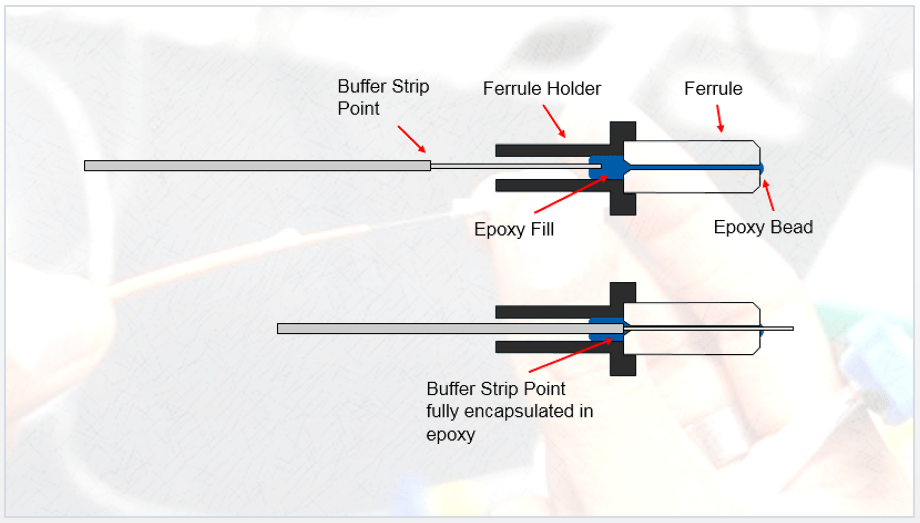Errors in epoxy processes (mixing, dispensing / application, curing schedules, etc.) can lead to premature bond failures which negatively impact the reliability of any cable assembly. In response to our industry needs for the most timely information and solutions around these critical processes, FOC developed an Epoxy & Adhesives Library that includes Blog Articles, Tips and FAQs and Videos. In the article below, we review the objectives of epoxy dispensing.
Approaches to dispensing adhesives (for fiber optic cable assembly) and a new automated system
The primary objective of a dispensing system is to inject a consistent and controllable amount of adhesive into the ferrule and connector. Secondary objectives — such as lower labor or "takt" time, lower cost of use, etc. are very important, of course — but they are irrelevant if the dispense quantity cannot be adequately controlled. The fact that most 2-part epoxies used in fiberoptic terminations have a working life in the range of hours, and the epoxy viscosity will gradually increase during that time, creates challenges to control the epoxy injection process, regardless of dispensing method.
A "proper" epoxy dispensing process should consider the following:
- The entire ferrule-hole bore should be completely filled with epoxy.
- In most dispensing processes, this is a achieved by injecting epoxy up through back-end of the ferrule, until a small bead of epoxy exits on the ferrule end-face (the "epoxy bead"). Less common is use of vacuum system to "pull" epoxy at the back-end of the ferrule through the ferrule bore, until it exits on the ferrule end-face. Both achieve the same goal.
- The back-end of the ferrule (where it is pressed into the ferrule-holder) should have sufficient epoxy fill to ensure the fiber strip point can be fully encapsulated with epoxy.
- Too little epoxy, or large voids in the epoxy, may cause the fiber to not be fully encapsulated, drastically increasing risk of fiber breakage.
- Too much epoxy may spill-over the ferrule holder after inserting the fiber, which may lock-up the connector spring-action.

The “Epoxy Injection” process in a cable assembly line is one that requires robust process controls, as it is nearly impossible to verify the effectiveness of the injection (proper ferrule fill) with subsequent testing — if there is not enough epoxy injected into the ferrule, the only way to find out is through destructive testing (i.e. cross-sectioning) or product failure.
Of course, manual epoxy injection can be relatively labor-intensive and is a “skill” that requires adequate training and monitoring. As a result, factories may benefit from investing in more expensive dispensing systems that minimize labor while improving epoxy fill control, which results in lower scrap and a more reliable product.
Three methods of dispensing adhesive
Again, with the main goal being careful control over the amount dispensed, one of three approaches are most commonly used:
- Manual: This approach relies on the skill of a well-trained operator to press the syringe’s plunger, inspect the end-face bead, and determine when the ferrule is correctly filled. Manual dispensing can be practical for small-scale assembly operations. It requires little capital outlay, and well-trained operators can achieve good results.
- Pneumatic: In this approach, an operator prepares the syringe and then connects it to a machine that uses controlled air pressure to press the piston and dispense a controlled amount of adhesive. Digital electronic controls regulate the air pressure to compensate for the reduced amount of adhesive in the barrel after previous “shots” and for changes in an epoxy’s viscosity over its working life. Some robotic versions also incorporate a vacuum system to pull air from the ferrule end-face hole – to help draw the adhesive through the ferrule and form the bead.With pneumatic dispensing, the process is less dependent on operator training, but there is additional capital outlay for the equipment. The advantage is greater control over the quantity of adhesive being dispensed with each shot vs. manual injection. Changes to epoxy viscosity through its working life will affect shot size, and the better pneumatic dispensing systems can be programmed to address this. Pneumatic systems can be suitable for small- to large-scale injecting needs, and they are excellent for operations with a large mix of products.
- Volumetric displacement: This method uses a threaded shaft to push the syringe’s piston. The electronic system that turns the shaft can keep track of the amount dispensed with each shot and alert the operator when it is time to load a new syringe. The displacement approach achieves, at least in theory, the most accurate and repeatable dispensed epoxy quantity, and it requires the least amount of operator training. This method is well-suited for any operation, but is significantly more expensive that other methods, and thus is generally considered by larger-volume operations, with more rapid ROI.
Automated dispensing systems
Pneumatic or displacement dispensers can be used with robotic positioning systems to implement an automated dispensing system. Such a scheme requires an operator to load the syringes and to mount the dispensers or “guns” in the robotic positioner, but it can achieve a substantial reduction in operator time and staffing needs at a large-scale operation. Once the system is loaded, an operator can move on to loading other stations or other tasks. The robot then positions the needle in the ferrule, dispenses the correct amount of adhesive, moves onto the next ferrule (usually in tray or rack), and records data about the ferrules in each run.
Robotic systems save labor, but the actual dispensing method is still either pneumatic or displacement. Some robots incorporate vision systems to ensure alignment when inserting the needle into the ferrule’s rear hole. Others use precise positioning systems. These systems contribute to costs, so an assembly company needs large-quantity orders with specific connector types to take full advantage of robotic dispensing.
Volumetric Dispensing System details can be viewed in the FOC marketing blog, Epoxy Dispensing “airfree” displacement technology, on the Fishman Corporation SmartAutomationTM Benchtop Fiber Optic Assembly System here.
Conclusion
Assembly manufacturers select the dispensing method and level of automation to meet their needs, depending on their order quantities, connector types, and workflow. In any case, assembly companies can work with Fiber Optic Center to implement the optimum system for their specific circumstances.



